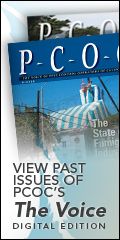
| July 2010 | Past Issues | Printer-Friendly | Advertise | Affiliates Search | Find a Pest Control Operator | PCOC.org |
|
EVP NOTES
 On Friday, July 2, 2010, at the PCOC board of directors meeting in Monterey, Curtis Good was sworn in as a member of the Structural Pest Control Board (SPCB) by Chris Reardon, deputy director of DPR. Curtis was appointed by Gov. Arnold Schwarzenegger and will serve a four-year term of office. This important event in the life of our association brought me to reflect upon the significance of the SPCB to our industry and I would like to share with you some of my thoughts...some of which you may also have considered and some which hopefully will set you thinking about the future. On Friday, July 2, 2010, at the PCOC board of directors meeting in Monterey, Curtis Good was sworn in as a member of the Structural Pest Control Board (SPCB) by Chris Reardon, deputy director of DPR. Curtis was appointed by Gov. Arnold Schwarzenegger and will serve a four-year term of office. This important event in the life of our association brought me to reflect upon the significance of the SPCB to our industry and I would like to share with you some of my thoughts...some of which you may also have considered and some which hopefully will set you thinking about the future.
One fact which always surprises me, and impresses legislators, is that PCOC was the prime mover in forming a board which would regulate the pest control industry. For a state trade association to want to regulate itself it a very rare thing around Sacramento! During the early 1930s several loosely formed associations merged into one in order to drive fraudulent pest control operators out of the industry. They lobbied the Legislature to form a structural pest control act and a regulatory board. On Jan. 1, 1936, the Structural Pest Control Act took effect. An interesting anecdote is that the first conviction under the new structural pest control act came in March of 1936 when R.W. Broadsman was sentenced to 30 days in jail, and fined $50 for operating in Pasadena without a termite control license. It is, I believe, very significant that in the Act, it states that "it is the intent of the Legislature that consumer protection is the primary mission of the board." In fact the mission statement of the board is as follows: "The Structural Pest Control Board's highest priority is to protect and benefit the public by regulating the pest control industry." As we move toward the future, the SPCB is now under the authority of the Department of Pesticide Regulation and it is proposed, supported by the PCOC board of directors, that appointments to the board will now be made by the director of DPR, to ensure a smooth operating board: one which will always have a quorum to carry on its critical function of protecting the consumer. During the transition process, an executive team from PCOC had a series of meetings with the executive team at DPR to discuss all of the options for the board's integration within DPR. These meetings will continue over the coming year. The top priority for PCOC is the preservation of the board intact and to make sure that the consumer protection function of the SPCB is firmly conserved within the new functioning under DPR. All of these priorities were taken very seriously at DPR: especially gratifying for us since this was unfamiliar territory for them! As an industry, we are very fortunate to have such a mutually respectful relationship to the SPCB. I am convinced that this relationship will long continue because of the commitment of so many dedicated leaders within the pest control industry in this great state of ours. We should not take this for granted as the majority of trade associations do not have such a situation. We should all count our blessings that we enjoy such a privileged state of affairs. LEGISLATIVE UPDATE
The 2010-2011 legislative session has begun, and you can review the matrix here: Legislative Matrix.
UPCOMING EVENTS
2010 September 8 September 10 September 24-25 December 10-11 2011 March 25-26 April 26-27 June 3-4 June 23-25 September 23-24 BILLY'S BULLETIN BY BILLY GAITHER
2010 PCOC FUMIGATION BANNER CONTEST As announced by Stan Woodward of DowAgro Sciences at the 2010 Convention in Monterey these are the winners of the 2010 Fumigation Banner Contest. First Place Orange County Pest Control Second Place Tiger Termite Third Place Clark Pest Control – Lodi Fourth Place Ecola Services of Southern California Congratulations to all the winners. EPA RENOVATION, REPAIR AND PAINTING CERTIFICATION UPDATE To facilitate the transition to full implementation of the RRP Rule, EPA will offer additional and sufficient time for renovation firms and workers to obtain the necessary training and certification to comply as follows: · Until Oct. 1, 2010, EPA will not take enforcement action for violations of the RRP Rule's firm certification requirement. · For violations of the RRP Rule's renovation worker certification requirement, EPA will not enforce against individual renovation workers if the person has applied to enroll in, or has enrolled in, by no later than Sept. 30, 2010, a certified renovator class to train contractors in practices necessary for compliance with the final rules. Renovators must complete the training by Dec. 31, 2010. EPA is still enforcing the compliance of the RRP practices. NOTE: In view of the paramount importance of ensuring that all contractors follow the lead-safe work practices in the RRP rule, EPA will continue to enforce the work practice requirements in the rule which protect children and reduce lead exposure. PENDING RRP CHANGES · As of July 6, 2010, you will have to use the new/updated "Renovate Right" brochure. You may order copies from the EPA website. · As of July 6, 2010, the "Opt Out" provision of the RRP rules will no longer exist. · Pending future adoption include expansion of the RRP rules to include all "publicly accessible" buildings. Meaning if the public (customers, clients, etc.) ever enter the property then it falls under the RRP rules. (California already mandates this!) BED BUG SEMINARS On Sept. 8, 2010, in Oakland and on Sept. 10, 2010, in Anaheim PCOC and NPMA will be hosting all-day seminars on bed bugs. Our target audience will be the hotel industry, apartment managers association, property managers association other related industries and associations. The seminars will include presentations on bed bug facts and will include a panel of PCOs to answer questions. Please click on the links for either an attendee registration or an exhibiter registration. As an exhibitor this will be an opportunity to introduce yourself and your company to a huge market for bed bug control.
DONATIONS TO DR. VERNARD LEWIS'S LAB
At the board of directors meeting on July 2, 2010, in Monterey President Lee Whitmore reported that the funding to continue the work at Dr. Lewis's lab was running out, due to budget problems with the UC system. Several companies, members and affiliate members pledged over $23,000 to assist with the lab funding. We now have available on the association website, http://www.pcoc.org/ , a link where you may make a donation to Dr. Lewis's lab. Open the website and click on the "protecting the consumer" link on the left side of the website. When the page opens, go to the bottom and click on the "donate now" link. Once on that page just follow the instructions. ELECTIONS
Elections for new officers, trustees and directors was held at the association annual members meeting in Monterey. Below are the results. President Ron Suber President-Elect Steve Delk Treasurer Scott Howell Second Vice-President Travis Swope Third Vice President Robert Baker Secretary Matt Evans Affiliate Representative Casey Brierley PAPCO TRUSTEE Darrell Ennes and Marie Evans PEACOCK DIRECTOR Lee Blevins, Tom Meany and Lee Whitmore SCHOLARSHIP TRUSTEE Steve Adams and Bob Howell MEMBER NEWS
This took place just before convention this year. Click here to read more about it: MEMBER VALUE PROGRAM
PCOC MONTHLY INSURANCE/SAFETY TIP
Almost 12 percent of the civilian workforce is 55+ years old, according to the Bureau of Labor Statistics (BLS). The BLS further projects workers 65+ will account for nearly 5 percent of the workforce by 2016. Older Workers = Safer Workers
Older workers have more experience and are less likely to rush through work that requires attention to detail. The BLS reports that the incidence of injuries (per 10,000 hours of full-time work) is lowest among workers 65+. Additionally, older workers in relatively hazardous manufacturing and construction-related industries have a lower frequency of workers' comp claims than younger workers, according to the National Council of Compensation Insurers (NCCI). Higher Severity
However, the picture isn't entirely rosy for older workers. Older workers tend to have higher medical costs. NCCI estimates that medical costs are 26 percent higher for workers 65+. An injury to an older person costs more to treat because it takes longer for them to heal and damage is usually more extensive. For example, if a 60-year-old woman falls, she might break her wrist if osteoporosis has weakened her bones, whereas a 20-year-old might only suffer a strain in the same fall. Older workers also lose more days on medical leave. NCCI reports that average indemnity payments per lost wage claim begin to increase at age 45, but then decline somewhat after age 65 – probably because workers who continue to work after 65 have relatively low salaries. Additionally, older workers usually want to get back to work. Understanding Older Workers
Older workers' health and wellness needs differ from those of younger employees. Physical strength peaks between 20 and 30 years of age, so older workers who do physical activity are working closer to their maximum capacity. Reaction time declines with age; eyesight and hearing also diminish. However, according to the Department of Health & Human Services (DHHS), age is less a factor in physical health than other factors such as obesity, smoking, lack of exercise and diabetes. Mental abilities also change as people age. Older workers have slower cognitive speed. According to DHHS, they retrieve information more slowly and learn more slowly. However, they are ultimately equally successful in learning new things and may have greater retention of new material.
Loss Prevention
Slip/trip/fall injures are the biggest risk to older workers, accounting for 47 percent of injuries, versus only 20 percent for all workers, according to BLS. Older workers are also more apt to have shoulder, arm and lower back injuries. Employers should analyze jobs to make sure all employees, regardless of age, are not continuously doing repetitive-motion activities and do not lift items that are too heavy for their strength. Tasks should be modified to prevent problems. Employers should evaluate their lighting systems, ensure they have slip-resistant flooring and make sure entrances, walkways and parking lots have smooth, non-slip surfaces that are well lit – basic loss control measures that will benefit all employees. When training employees about new tools – whether it's machinery or computer software – older workers need a slower-paced class, while young workers may need a follow-up refresher. Wellness programs for employees of all ages can also have a positive impact on the severity of workers' comp claims. A healthier employee generally recovers faster than one who is overweight and out of shape. For more information on safety and wellness, please contact the PCOC Insurance Program Department at Jenkins Insurance Group: (877) 860-7378. FREQUENTLY REQUESTED INFORMATION
TEMPORARY NPMA LOGIN FOR JOINT MEMBERSHIP LOGIN: 313501 PASSWORD: PCOC PCOC Web site password for 2010-2011: "termite" Please remember, the password changes every July 1! Department of Fish & Game Department of Food & Agriculture Department of Pesticide Regulation Find Your Legislator Healthy Schools Act Structural Pest Control Board |
Pest Control Operators of California |
 |





